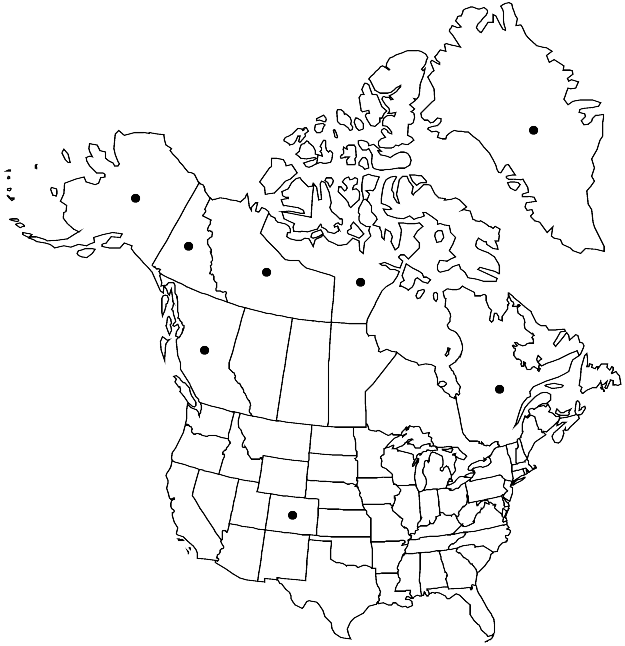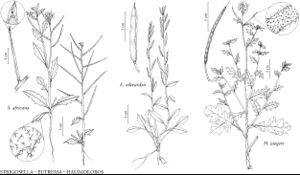Eutrema edwardsii
Chlor. Melvill., 9, plate A. 1823.
Perennials; (roots fleshy). Stems simple or few from caudex, erect, unbranched, (0.3–) 0.8–3 (–4.5) dm. Basal leaves (soon withered); rosulate; petiole 1–4.5 (–6) cm; blade (somewhat fleshy), ovate, lanceolate, or oblong, (0.3–) 0.8–2 (–2.5) cm × (1–) 4–14 (–18) mm, (base truncate, obtuse, or cuneate, sometimes oblique), margins entire, apex obtuse. Cauline leaves 3–7 (–10); petiolate or (distal) sessile; blade ovate, lanceolate, oblong, or linear, (0.7–) 1–3 (–4) cm × (1–) 3–10 (–14) mm, base cuneate, margins entire, apex subacute. Racemes considerably elongated in fruit. Fruiting pedicels divaricate to ascending, (curved-ascending or straight), (1.5–) 3–10 (–15) mm. Flowers: sepals ovate, 1.5–3 × 1–1.5 mm, (margins membranous); petals spatulate, 3–5 × 1.5–3 mm; filaments 2–2.5 mm; anthers ovate, 0.2–0.4 mm; gynophore usually 0.2–1 mm, rarely obsolete. Fruits stipitate, not torulose, linear to narrowly oblong, (0.7–) 1–2 (–2.5) cm × 2–3 mm slightly 4-angled; valves (cuneate basally and distally), each with prominent midvein; septum mostly perforate; ovules (6–) 8–12 (–14) per ovary; style 0.2–1 mm. Seeds usually oblong, rarely ovoid, (1.5–) 2–3 × (0.7–) 1–1.5 mm. 2n = 18, 28, 42, 56.
Phenology: Flowering early Jun-early Aug, fruiting Jul-early Sep.
Habitat: Tundra, talus slopes, glaciated hills, grassy margins of streams, wet areas of peat ridges
Elevation: 0-3900 m
Distribution

Greenland, B.C., N.W.T., Nunavut, Que., Yukon, Alaska, Colo., Asia (Mongolia), Asia (Russia)
Discussion
Plants of Eutrema edwardsii from Alaska, northern Canada, and Greenland grow at elevations of 0–1900 m; those of Colorado, treated by R. C. Rollins (1993) as E. penlandii, grow at 3700–3900 m.
An examination of collections of Eutrema edwardsii from its entire range amply demonstrates that it is a highly variable species that can easily accommodate E. penlandii. Although the latter is known from the high mountains of Park County (Colorado), its plants are indistinguishable from those of E. edwardsii from Greenland, and the higher latitudes in Alaska, British Columbia, Northwest Territories, Nunavut, and Yukon. In general, plants of E. edwardsii from lower latitudes tend to be far more robust than those of higher latitudes. R. C. Rollins (1993) indicated that E. penlandii is distinguished from E. edwardsii by having stems less than 10 (versus 10–45) cm, lingulate (versus obovate) petals, fruiting pedicels less that 4 (versus 5–10) mm, infructescence less than 5 (versus to 20) cm, and cordate (versus truncate or cuneate) basal leaves. In fact, the petals of E. penlandii are spatulate, just as those of most plants of E. edwardsii, and the basal leaves in E. penlandii (e.g., Penland 3909 and Weber 13315, both at GH) are cuneate. Furthermore, some plants from Greenland (e.g., Raup et al. 465, GH) are almost identical to those of E. penlandii, and they are only 3–8 cm with narrowly obovate petals, fruiting pedicels 2–4 mm, and infructescence 2–3 cm. Other examples of E. edwardsii that show some or all of the above aspects of E. penlandii could be cited. Weber treated E. penlandii as a subspecies of E. edwardsii, but the only difference I see between the two is geographic. Such distinction is unacceptable because the widely disjunct populations of E. edwardsii within Russia would have to be treated that way too.
As Eutrema penlandii, E. edwardsii is in the Center for Plant Conservation’s National Collection of Endangered Plants.
Selected References
None.
Lower Taxa
"elongated" is not a number."thick" is not a number."dm" is not declared as a valid unit of measurement for this property."dm" is not declared as a valid unit of measurement for this property.
